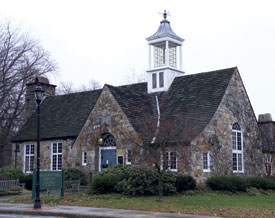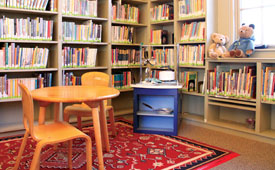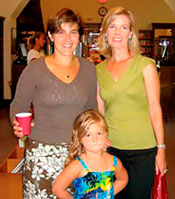How the Branches Were Saved
Steve Maas writer
Beth Furman photographer
 Their strategy was to spread their passion: among friends and friends of friends, up and down streets, and throughout neighborhoods. They made phone calls, knocked on doors, sent e-mail blasts, and held dozens of coffees and cocktail parties.
Their strategy was to spread their passion: among friends and friends of friends, up and down streets, and throughout neighborhoods. They made phone calls, knocked on doors, sent e-mail blasts, and held dozens of coffees and cocktail parties.
They recognized that the key to their success was to break with the past and champion change.
Sounds like the playbook to elect a president. But this one succeeded in reopening a pair of beloved branch libraries.
Two years ago, the prospect of saving Wellesley’s Fells and Hills branch libraries appeared as remote as Barack Obama’s chances of winning the White House. For the second consecutive year, a tax override had failed to keep them open.
The voters had spoken, but theirs was not to be the last word. This is the story of how a small band of volunteers persuaded 400 people to donate more than $325,000—giving the branches a five-year reprieve in which to raise money for a permanent endowment. It is a story that other municipalities—such as neighboring Newton—are looking at as tight finances force them to close their branch libraries.
The intrepid band includes a corporate attorney, a business consultant, a speech pathologist, and a dog-walker. They waged their campaign in parks and playgrounds, living rooms and stores, and—most effectively—with open houses at the branches themselves. They even enlisted the town’s children, who filled piggy banks with more than $7,000 by selling lemonade, holding yard sales, and sweet-talking their grandparents.
“I was terribly saddened at the thought that our community would even consider closing libraries,” says Amanda Henshon, who many credit for firing up the branch campaign. Henshon, a corporate lawyer who is taking time off to raise her three young children, made the branches part of her successful campaign for library trustee in 2006. The message of the override vote, she says, “was not to close the branches. The vote was about public funding at a time when public funding was incredibly tight.”
Getting past “no”
“So many times you’re afraid to ask because someone will say no,” said Ann-Mara Lanza, who co-chaired the “Campaign to Re-Open the Branches.” “If you don’t ask, they won’t be able to say yes. So it’s a matter of working up the nerve.”
On a rainy afternoon, Lanza sat in the reading room of the Hills branch a few blocks from her home and talked about the crucial months of a campaign that at times looked like a lost cause. The room, with its barrel-shaped ceiling and huge fireplace, now looks much as it did when the library opened in 1928. It is even furnished with the original tables and chairs.
 Lanza, who became a branch fan through her two young children, took on the helm of the campaign at the urging of Henshon, who also enlisted the other co-chair, Lynne Brady Wagner.
Lanza, who became a branch fan through her two young children, took on the helm of the campaign at the urging of Henshon, who also enlisted the other co-chair, Lynne Brady Wagner.
“We realized quickly that we didn’t know what we were doing,” Lanza said, recalling an organizational meeting in September 2007. By then, the campaign had raised about $75,000 toward its $325,000 goal, thanks largely to a “Brunch for the Branches” a half year before.
That goal may not seem like much for a town like Wellesley. After all, in 2005, parents raised $380,000 in a failed bid to persuade the School Committee to restore an elementary school Spanish program. The branch libraries, however, had no financial angels to come to their rescue. “Professional fund-raisers thought we should find someone who could give us $50,000,” Lanza says. “Our money didn’t come from a couple of large contributors, but many smaller donors.”
Lanza holds an MBA from the Wharton School and, before taking time off to raise her children, worked as a marketing consultant for big companies like Pepsi. But, she said, “it’s one thing to put together a beautiful marketing campaign, another to sit down with someone and ask for money.”
Lanza and Wagner credit Carolyn Wood, who became the library’s director of development in October 2007, with jumpstarting the campaign. Wood brought both passion for books and expertise in fund-raising to the job. Her mother was a librarian. Before spending 10 years as a stay-at-home mom, Wood worked for a capital giving group at Harvard University. She picked up more fund-raising experience—and Wellesley contacts—serving on the capital campaign for the main library and on the board of the Friends of Wellesley Library.
 “Fundraising is a science—meaning numbers, data, and analysis—but there is also a real art to it,” said Wood. “And the art to it is making your case.” That meant persuading donors that the goal was not just to reopen the branches, but to re-invent them. In the past, the branches had been, in effect, miniature versions of the main library. That formula didn’t make sense anymore, especially with the opening in 2003 of the new main library.
“Fundraising is a science—meaning numbers, data, and analysis—but there is also a real art to it,” said Wood. “And the art to it is making your case.” That meant persuading donors that the goal was not just to reopen the branches, but to re-invent them. In the past, the branches had been, in effect, miniature versions of the main library. That formula didn’t make sense anymore, especially with the opening in 2003 of the new main library.
“We can’t talk about the branches as if they’re a separate entity,” Wood said. Instead, the campaign cast the library as “one institution with three locations.” The branches’ new role would be to provide a comfortable reading space; lend best-sellers, CDs, and children’s material; and host book groups, informal study hours, and classes. The branch committee made it a point to solicit ideas along with donations.
The game plan
While Lanza has lived in Wellesley for 15 years, her co-chair, Wagner, moved to town just three years ago. In addition to the schools, she was drawn to the Hills branch. She looked forward to walking there with her three young children. But by the time the family had unpacked their boxes, the branches were closed. From the start, Wagner said she felt an obligation to help reopen them. Like Lanza, she didn’t have any serious fund-raising experience. But challenge didn’t daunt her. A speech pathologist, she heads the Stroke Rehabilitation Program at Spaulding Rehabilitation Hospital.
 Early on, the 20 or so members of the branch committee pooled their knowledge of the community to come up with a list of 100 potential donors. “We discovered on our committee that there were very few people comfortable with approaching strangers,” said Lanza. When no one agreed to approach one particularly promising couple, Wagner piped up, “Darn it, I’m going to call. Let’s see what happens.”
Early on, the 20 or so members of the branch committee pooled their knowledge of the community to come up with a list of 100 potential donors. “We discovered on our committee that there were very few people comfortable with approaching strangers,” said Lanza. When no one agreed to approach one particularly promising couple, Wagner piped up, “Darn it, I’m going to call. Let’s see what happens.”
Knowing that the couple had been major contributors to town causes over the years, Wagner told them “how tremendously grateful people were.” She talked about the library’s role as a community gathering center, “a place that serves every single member of the town every day.” And then she noted that with the branches closed, some residents, particularly older ones, can’t get to the library. “That really connected for them,” Wagner said. A few weeks later, the couple donated $10,000.
Lanza found that the most effective approach was to start a conversation. “If you want someone to share your passion, you have to listen to them as well.” With other moms, she would talk about how the branches offered a snug, safe space, “where kids can look at books and you can look at books.” With older people, she would talk about their memories of the libraries and of the town.
Lanza and Wagner, who each served as point person for a subgroup of committee members, met weekly with Wood. They mapped strategy and discussed who’d been contacted, needed to be contacted, or shouldn’t be contacted. “We wanted to be very respectful and professional,” Wagner said.
The Poet’s muse
If you’re reading this article on a nice sunny morning, Rebecca Meier is probably out walking dogs—one of her many occupations, which also include raising four children and brewing brainstorms. As one of the members of the branch committee, she came up with the idea of selling donors on the idea of giving a dollar a day for three years (which some contributors took literally, sending checks for $1,095), and the Poets’ Corner Neighborhood on giving as a group. “I’m a big vision person,” she said.
In a previous life, Meier worked in the computer field. Video-conferencing had been one of her specialties. Having spent so much time meeting people virtually, she appreciates how her current job allows her to meet them in the flesh. “There are a lot of people with dogs out walking,” she said. And she filled them all in about the library campaign.
Meier made the branch campaign the topic of one of the monthly dinners held by a group of women in her neighborhood. With Lanza and Henshon attending to answer questions, the wine flowed along with ideas for the branches. Meier also publicized the campaign through the e-mail list for her neighborhood’s progressive dinners. Word spread quickly as supporters hosted intimate coffees, often with library trustees or the director in attendance.
Another Meier brainstorm was inviting “’tweens”—boys and girls aged nine through twelve—to the Hills Branch early last year to talk about what they wanted from the library. They filled poster page after poster page with ideas. They loved the convenience of a library to which they could bike and request particular titles, have special study hours, and have computer access. And their enthusiasm prompted not a few parents to write a check for “a free place for all ages to read and convene.”
In all, the Poets’ Corner Neighborhood raised more than $50,000, earning naming rights for the beacon atop the Hills branch. “Every time I go by,” Meier said, “I say to the kids, there’s the light, it’s on; the library is open.”
The veteran warrior
After having fought to keep the branches open in the early 1990s, Valentina Cannell wasn’t going to let impending knee surgery stop her from battling for them now. Cannell recalled how the branches would host evening story times, with fathers accompanying their pajama-clad kids, and how older people would make a stroll to the branch a big part of their social life. A town resident since 1961, Cannell says another reason she joined the campaign was her dismay over redevelopment of the town. “There is no attention being paid to the historical buildings that they are tearing down,” she said.
With her experience in previous branch efforts, Cannell provided the committee with institutional memory. She stressed the importance of being up front with the community about fund-raising goals and spending plans. “Personally, if I’m going to be asked to give money to something, I want to know all of the details,” she said.
Late-night panic
Lanza, who was elected library trustee in 2008, said she was “famous on the committee for sending e-mails with ideas at 3:00 in the morning.” During the dark days of winter, when the checks slowed to a trickle or a promising donor failed to come through, she would wonder whether the branches would ever reopen.
A key moment came about three quarters of the way through the campaign when the branch committee approached the Friends of the Wellesley Free Library for a donation of $10,000. Mary Ann Cluggish, the library trustees’ liaison to the Friends, thought the committee should have asked for more. With that in mind, Cluggish gave the Friends a tour of the Hills branch. She showed the group the fireplace, which could be named in its honor, and suggested a donation of $25,000. As it turned out, that was just the figure the Friends had in mind. “I knew that was a fitting and appropriate gift for them to give,” said Cluggish.
The Friends’ gift paid for things like wireless Internet, book racks, and refurbishing furniture. It also “got everyone energized again,” Lanza said. “We’d be getting all these little gifts, and we’d be thinking, ‘Are we going to actually make it to the end?’ And then we get this gift. And boom! we are going to make it.”
Good timing
Besides savvy promotion, teamwork, and hard work, luck must be included as a key factor in the fund drive’s success. “We’re very happy we’re not in a campaign now,” says library trustees chair Marla Robinson, referring to the current economic downturn. “It was absolutely in the nick of time.”
Had the economy turned sour sooner it would have left the branches shuttered at a time when they are needed most. “The library actually gets busier in times like now,” Robinson said. “The amount of people who want to use the library goes up in hard economic times.”
Janice Coduri, the Wellesley library director, became a grandmother a couple of months after the branches reopened. As Coduri talks about the many activates the branches host, she imagines one day taking her granddaughter to a “Book Babies” event.
Other activities include “Laptop Lab,” “Bring-Your-Own Crafting Circle,” “Afternoon Book Chat and Tea,” and the “Middle School Book Club.” Coduri says, “We’re trying things out to see what works.”
Most of the action is at the Hills branch, where aisle bookcases were removed to open up the space. “When we listened to what people wanted, we de-cluttered it,” Coduri said. The smaller Fells branch, which is leased part-time to the Wellesley Community Children’s Center, is only open the latter part of the week.
Over at the Fells one Saturday in late fall, Michael Humphreys stopped by to pick up a book he had ordered from the main library. The Fells is the oldest, continuously-used public building in town, having opened as a one-room schoolhouse more than 150 years ago. Today it’s filled with pint-size tables, but its shelves reflect the wide spectrum of its users, from: How Do Dinosaurs Say Good Night, to Robin Cook’s Foreign Body, as well as a selection of large-print books.
Humphreys, who serves on several town boards, says the success of the branch campaign reflects Wellesley’s strength as a community. “When people want something, they get behind it.”

